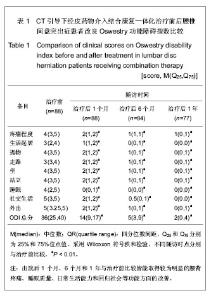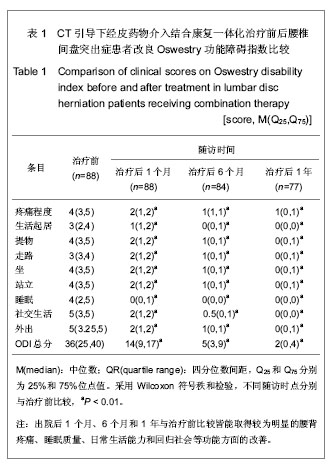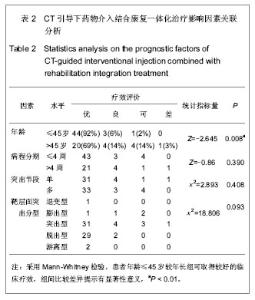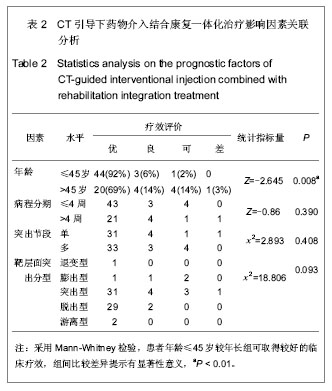| [1] Manchikanti L, Singh V, Falco FJ,et al.An updated review of automated percutaneous mechanical lumbar discectomy for the contained herniated lumbar disc.Pain Physician. 2013; 16(2 Suppl):SE151-184.
[2] 邱贵兴,费起礼,胡永成.骨科疾病的分类与分型标准[M].北京:人民卫生出版社,2009:112.
[3] 严隽陶.推拿学[M].北京:中国中医药出版社,2003:142-147.
[4] Akuthota V, Ferreiro A, Moore T,et al.Core stability exercise principles.Curr Sports Med Rep. 2008;7(1):39-44.
[5] 刘绮,马超,伍少玲,等.Oswestry功能障碍指数评定慢性腰痛患者的效度分析[J].中国康复医学杂志,2010,25(3):228-231.
[6] Macnab I.Negative disc exploration. An analysis of the causes of nerve-root involvement in sixty-eight patients.J Bone Joint Surg Am. 1971;53(5):891-903.
[7] 童国海,黄蔚,陈玮,等.CT引导硬膜外皮质类固醇注射治疗坐骨神经痛的远期疗效评价[J].介入放射学杂志.2005,14(3):287- 289.
[8] Sen O, Aydin MV, Bagdatoglu C,et al.Can E-selectin be a reliable marker of inflammation in lumbar disc disease. Neurosurg Rev. 2005;28(3):214-217.
[9] Alexandre A, Corò L, Paradiso R,et al.Treatment of symptomatic lumbar spinal degenerative pathologies by means of combined conservative biochemical treatments. Acta Neurochir Suppl. 2011;108:127-135.
[10] 王涛,马信龙,张晓林,等.腰椎损伤疝出型和退变突出型椎间盘组织白细胞介素17表达与Modic改变的关系[J].中华骨科杂志, 2012,32(4):356-361.
[11] Tufan K, Sen O, Cekinmez M,et al.Comparison of E-selectin and the other inflammatory markers in lumbar disc herniation: a new promising therapeutical window for radicular pain.J Spinal Disord Tech. 2012;25(8):443-446.
[12] Fritz JM, Thackeray A, Childs JD,et al.A randomized clinical trial of the effectiveness of mechanical traction for sub-groups of patients with low back pain: study methods and rationale. BMC Musculoskelet Disord. 2010;11:81.
[13] 赵磊,穆敬平,彭力,等.针灸治疗腰椎间盘突出症的数据挖掘研究[J].江苏中医药,2012,44(3):54-56.
[14] 孙冬梅,廖颖烨,鹿传娇,等.针刺治疗腰椎间盘突出症的优化方案研究[J].上海针灸杂志,2012,31(7):498-500.
[15] 吴耀持,于允勤,张峻峰.针刺对大鼠受损腰神经根超微结构及炎性介质的影响[J].中国临床康复,2005,9(37):182-184.
[16] Cho YJ, Song YK, Cha YY,et alAcupuncture for chronic low back pain: a multicenter, randomized, patient-assessor blind, sham-controlled clinical trial.Spine (Phila Pa 1976). 2013; 38(7):549-557.
[17] Xu M, Yan S, Yin X,et al.Acupuncture for chronic low back pain in long-term follow-up: a meta-analysis of 13 randomized controlled trials.Am J Chin Med. 2013;41(1):1-19.
[18] Ambrósio EM, Bloor K, MacPherson H.Costs and consequences of acupuncture as a treatment for chronic pain: a systematic review of economic evaluations conducted alongside randomised controlled trials.Complement Ther Med. 2012;20(5):364-374.
[19] Yuan WA, Huang SR, Guo K,Integrative TCM Conservative Therapy for Low Back Pain due to Lumbar Disc Herniation: A Randomized Controlled Clinical Trial.Evid Based Complement Alternat Med. 2013;2013:309831.
[20] 周楠,房敏,朱清广,等.脊柱微调手法治疗腰椎间盘突出症的腰背肌生物力学性能评价[J].中国康复医学杂志,2012,27(2):115- 119.
[21] 师宁宁,沈国权,何水勇.骶髂关节紊乱与L4~5椎间盘突出的关系研究[J].中医正骨,2013, 25(1):23-25.
[22] 师宁宁,沈国权,何水勇,等.腰5骶1椎间盘突出症与骶髂关节紊乱之间的相关性流行病学调查[J].中国中医骨伤科杂志,2012, 20(11): 37-40.
[23] Manchikanti L, Buenaventura RM, Manchikanti KN,et al.Effectiveness of therapeutic lumbar transforaminal epidural steroid injections in managing lumbar spinal pain.Pain Physician. 2012;15(3):E199-245. |



